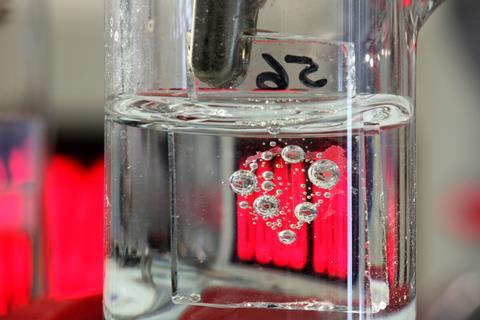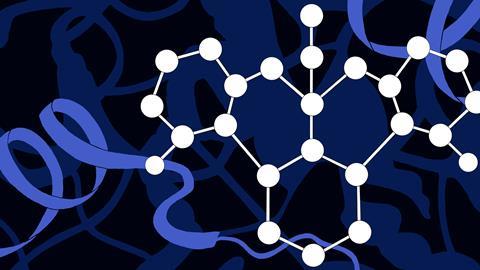There are natural metalloenzymes that make difficult chemistry look easy. James Mitchell Crow talks to the bioinorganic chemists figuring out how to copy them
Head north-west from the Twin Cities of Minneapolis–Saint Paul, the midwest US metropolis not far from the Great Lakes, and you’ll soon reach vast, wide, open space: the great plains of North America. But keep going, and eventually – 500 miles from Minneapolis – you hit the Bakken Fields. This area of North Dakota is a fracking hotspot and a major source of US oil.
The Bakken Fields produce methane as well as oil. But North Dakota’s remote location currently rules out doing anything useful with it, explains Lawrence Que, a bioinorganic chemist at the University of Minnesota. ‘So we are burning off the methane because it is a worse greenhouse gas than carbon dioxide,’ he says. By night, the area is lit up so brilliantly that it shines as brightly as a major US city in satellite images. ‘Transporting the methane is just not economically feasible. Between me in Minneapolis and the Bakken fields, there’s virtually nothing.’
But not entirely nothing. There are lakes, teeming with microorganisms. At the bottom of these lakes reside methanogens, bacteria that make methane as part of their everyday metabolism.
My career has focused on how these enzymes work, and how we can develop synthetic catalysts that can do some of these transformations
Lawrence Que, University of Minnesota
The microbes that interest Que are found in the lakes’ central layers. ‘The methanotrophs sit in the middle, where they can get the methane from the bottom and oxygen from the top,’ says Que. Bringing these two molecules together fuels their existence. ‘They turn methane to methanol, which is a very interesting transformation for our time,’ Que says. If we could convert the Bakken Fields’ methane into methanol as readily as the methanotrophs do, transporting the resulting liquid suddenly becomes far more feasible, he says.
Making methanol from methane is a non-trivial transformation, requiring the breaking of the strongest aliphatic carbon–hydrogen bond that there is. In the methanotrophs, non-heme iron-based enzymes called monooxygenase drive the conversion, accessing iron oxidation states of +4 or even +5 to form oxidants powerful enough to break carbon–hydrogen bonds as strong as methane’s.
Rather than try to tame the enzyme itself, Que is attempting to recreate the essence of its active site in a synthetic system and access similar levels of catalytic performance. ‘The last 30 years of my career has focussed on how these enzymes work, and how we can develop synthetic catalysts that can do some of these transformations,’ Que says. ‘My current holy grail is to be able to put an iron(v) complex in a bottle.’
Multistep process
Que is part of a large community of inorganic chemists looking to develop synthetic mimics of nature’s diverse metalloenzyme collection. ‘I think a lot of synthetic inorganic chemists see that the kind of things nature does with metals are the kinds of things we’d like to do synthetically,’ says William Tolman, an inorganic and biological chemist at Washington University in St Louis, US.

Many of these metalloenzymes have a mastery of small molecule activation, which – whether it’s efficiently turning inert dinitrogen into ammonia, accessing highly reactive species to break plant waste into biofuels or selectively breaking strong carbon–hydrogen bonds – encompasses many other interesting transformations of great current interest.
But in other ways, metalloenzyme research is timeless. ‘Small molecule activations are some the most fundamental reactions of nature,’ Tolman notes. ‘If you think about respiration and photosynthesis, those two reactions are fundamental to everything and they are both carried out by metalloenzymes.’
Teasing out how metalloenzymes catalyse the transformation of their substrates, so that we can copy them, is a stepwise affair. ‘You’ve got to know the structure before you can delve into function,’ Tolman says. In the early days of metalloenzyme research, some half a century ago, just discovering what the active site of these enzymes looked like was a major challenge. ‘Back then it was much more difficult to get structures. A lot of technique developments along the way have allowed us to obtain structures much more easily and reliably.’
The early methods for obtaining protein x-ray crystal structures, for example, could be very rough on enzymes. ‘When the manganese cluster of photosystem II was first structurally characterised, there were a lot of discrepancies in the structures from different labs,’ Tolman says. It turned out the protein was suffering radiation damage from the strong synchrotron radiation used for protein crystallography at the time. ‘Once that was figured out, people developed fast synchrotron techniques for collecting crystal structures with pulses of radiation, to avoid all the damage. Developments like that have played a big role.’
The structural methods in biochemistry have now become so sophisticated that describing the structure of metalloenzyme active sites is no longer the hurdle it once was, says Tolman – although challenges remain. The field’s new frontier is figuring out the enzyme’s reaction mechanism, in enough detail that we can recreate their performance in synthetic systems. ‘There’s a couple of areas where there has been a lot of recent activity,’ Tolman says. ‘One is nitrogenase.’
The nitrogenase enzyme takes dinitrogen from the atmosphere and splits its strong triple bond to make ammonia. That’s the same conversion industry achieves via the Haber–Bosch process for producing fertiliser – consuming more energy, and creating more carbon dioxide emissions, than any other industrial chemical process.
‘To get dinitrogen to do anything is a really difficult reaction, says Patrick Holland, an inorganic chemist at Yale University in Connecticut, US. ‘We try to understand what we can about the coordination chemistry nature is using in nitrogenase enzymes, and try to mimic that to help understand the enzyme, because we might use some of those same strategies for binding and activating nitrogen in synthetic catalysts,’ he says.
The structure of the nitrogenase enzyme active site hints at the size of the challenge. To produce ammonia, the nitrogenase enzyme uses not one iron atom, but seven – plus a molybdenum atom – in a cluster of metal and sulfur atoms. ‘It is becoming increasingly clear one of these sulfur-coordinated iron sites is where the nitrogen is binding,’ Holland says. But there are many subtleties to the structure and function of the nitrogenase active site that are still to be ironed out.
Ammonia dreaming
Even the final structural details of the nitrogenase active site have only recently been nailed down. ‘For years, people knew there was some light atom in the middle, but didn’t know if it was carbon, nitrogen or oxygen, because by x-ray crystallography, you can’t really distinguish,’ Holland says. In 2012, Serena DeBeer’s lab at the Max-Planck-Institute for Bioinorganic Chemistry in Mülheim, Germany, played the pivotal role in unmasking the mystery atom: it was carbon, in the form of a carbide bound to six surrounding iron atoms.1 ‘DeBeer’s group used a really fancy x-ray emission technique, where x-rays are absorbed and then emitted as a lower energy x-ray that depends on what atoms are around,’ Holland says.
People have tried for decades to recreate that shape in a synthetic system, and not one of us has succeeded
To help interpret the x-ray emission peaks from the enzyme, Holland’s group was one of the teams that supplied DeBeer with synthetic complexes that allowed them to calibrate their technique. Computation can give you hints, but computations on systems of that size are really challenging, Holland says. ‘Our synthetic complexes can basically act like a Rosetta stone that [allow you to] know how to interpret the spectroscopy on the enzyme.’
Holland and DeBeer, along with others, continue to collaborate, the work of one group informing the work of the other. ‘The spectroscopists will see something in the enzyme data, whether it’s kinetics or some mechanistic idea, and ask us “Is this mechanism reasonable, is it a feasible thing iron and sulfur could do?”’ Holland says. And the latest insights from the natural system inspire new synthetic mimics.
For synthetic chemists working on mimics of the iron–sulfur cluster, the challenge is the great complexity of the natural system. ‘The nitrogenase active site has got these eight metals all in a cluster, and they are in a strange shape. No one knows why that shape is beneficial. People have tried for decades to recreate that shape in a synthetic system, and not one of us has succeeded. That’s one of the big challenges in the field right now,’ Holland says.
In the meantime, Holland’s group makes synthetic systems that probe different aspects of the active site. In 2015, the team created an iron–nitrogen complex in which the metal atoms were coordinated only by sulfur and carbon atoms, like in the natural system.2 ‘It was electron rich, and especially good at back-bonding,’ Holland says. ‘We think that may be one of the key features nature took advantage of, that sulfur is a very electron-donating, which puts a lot of electron density onto the metal, and the metal can very effectively back-bond into the nitrogen to be extra good at reducing it.’ Pushing electrons into an antibonding orbital of the dinitrogen molecule would weaken the nitrogen–nitrogen triple bond, and help to crack it open.
The team also makes multi-iron complexes, to see how the iron atoms work together, and makes structures that incorporate that recently unveiled carbide. ‘These nitrogenases are the only natural systems with a carbide in them, which implies it is somehow useful for nitrogen activation, but no one really knows why that is,’ Holland says. Synthetic models should provide some clues.
Synthetic licence
Making a useful synthetic mimic of a metalloenzyme active site does not necessarily mean creating the closest possible copy of the natural system. In his lab at the Federal Polytechnic School at Lausanne (EPFL), Switzerland, Xile Hu recently showed that switching one metal for another can be a big step to making a practical catalyst inspired by a natural system.
Hu has been studying a hydrogenase enzyme that features a single iron atom as the only metal in its active site. In industry, catalytic hydrogenation one of the most common transformation used, but synthetic hydrogenation catalysts almost exclusively use precious metals. Enzymes do not have a lot of access to precious metals – but what they have had is millions or even billions of years to evolve highly active catalysts using earth-abundant metals, Hu says. ‘For a lot of reactions, if we want to get to a level of high activity [using earth-abundant metals], we need to study how enzymes do it,’ Hu says.

In the case of hydrogenases, many examples of iron–iron and iron–nickel bimetallic enzymes are known. Just as Hu began his independent career, the single-iron hydrogenases were discovered. ‘The structure was just revealed, so it was like a blank piece of paper,’ Hu says. Years of study, from Hu’s group and others, have since shown that this enzyme uses cooperative catalysis, in which the metal and part of the ligand work together to activate hydrogen. But in terms of making a synthetic mimic, the iron complexes produced so far have shown poor stability. So Hu took a new tack. ‘We tried to think beyond structural and functional models,’ Hu says. ‘To try to make a mimic of an enzyme active site, structurally, is very difficult. So we decided to simplify it, but taking the biological mechanistic insights to see what we can design.’
As well as the simplified ligand structure, the team switched from iron to manganese. ‘Iron(ii) and manganese(i) are isoelectronic, but typically manganese(i) compounds are more stable and easier to handle than iron(ii) analogues,’ he says. The resulting catalyst had the highest activity and broadest substrate scope of any iron hydrogenase mimic to date, the team showed.3 But the new catalyst’s pattern of reactivity is complementary to, rather than a replacement for, conventional hydrogenation catalysts, Hu suggests.
‘For a lot of common organic transformations, this enzyme mimic will compete, but is not necessarily better,’ Hu says. ‘But for biomimetic reactions, the biomimetic catalyst really outperformed other catalysts.’ The team showed the catalyst performed very well in an asymmetric relay hydrogenation, in which the catalyst hydrogenated a biomimetic chiral iron organometallic complex, which then asymmetrically hydrogenated the substrate. The process is akin to the way nature uses NADH and NADPH as hydride transfer reagents. ‘If you have a reaction with a biological resemblance, then an enzyme mimic might be better than synthetic catalysts. In that category I think we will see more examples, in reactions that are difficult or unknown in synthetic chemistry.’
Copper calling
In Tolman’s lab – like in Que’s – the focus is on how metalloenzymes activate oxygen. Both labs study methane monooxygenases, Que’s at iron-based examples, whereas Tolman looks at copper, and the nature of the highly oxidising copper–oxygen intermediate that is able to catalyse the oxidation of strong carbon–hydrogen bonds.
Tolman’s group also studies copper–oxygen based metalloenzymes called lytic polysaccharide monooxygenases (LPMOs), only discovered in 2010, which cleave recalcitrant carbohydrates such as cellulose.4 Bacteria, fungi and even wood-boring shipworms have since been shown to produce these enzymes. ‘This enzyme is really important for biotechnology applications, it is being used for biofuel plants as a catalyst for helping to break down polysaccharides into sugars for biofuel generation,’ Tolman says. The team has been trying to understand the nature of the copper–oxygen species, developing new copper–oxygen intermediates to see how they react.
Even though LPMOs are a diverse family of enzymes, with six distinct classes discovered so far, they all feature one key structure.5 The copper atom is bound by two nitrogen atoms in a structure dubbed a histidine brace. The copper-based methane monooxygenases feature it too – suggesting it is a crucial component of high-valent copper–oxygen catalysis. Studies so far suggest the histidine brace may be deprotonated to stabilise the high valent intermediate.
Taking lessons from biology is ultimately going to be driving new chemistry
Another copper enzyme, the even more mysterious ammonia monooxygenase, is the focus of Kyle Lancaster’s group at Cornell University in Ithaca, New York. ‘The methane monooxygenase and ammonia monooxygenase enzymes are related – the hypothesised intermediates are some sort of angry copper oxygen species – but almost nothing is known about ammonia monooxygenase,’ Lancaster says. The enzyme is an insoluble membrane protein. ‘The big challenge there is actually accessing the protein. Nobody has purified it. In the meantime, we can get some understanding of how these things work by collaboration with synthetic groups.’
With Theodore Betley at Harvard University, Lancaster has looked at carbon–hydrogen amination reactions with copper centres as an analogous system. ‘We think the reactivity is going to be similar: you generate a high-valent intermediate where you’re basically poising coordinated ligands to do a lot of the lifting for you.’ The team has been testing the notion that copper could even be oxidised to the +3 oxidation state, gathering x-ray absorption spectroscopy data that suggest a better way to think about it is that the ligands around the copper are donating a significant amount of electron density to the metal.6 So far, the team has looked at copper–nitrogen species. ‘We recently showed that what is formally a copper(iii) imido species, low-coordinate, is better described as a copper(i) nitrene,’ Lancaster says. ‘Meaning a neutral N donor, an almost naked nitrogen atom.’ The shift of electron density onto the metal makes for a powerful species for inserting the nitrogen into carbon–hydrogen bonds.7
Betley’s lab is now working to make complexes with oxygen donor ligands, more closely mimicking the ‘angry copper–oxygen species’ in the enzyme, Lancaster says. ‘We are showing that accessing sub-octet or electron-deficient oxygen donors gives you a reactive species that’s going to be capable of cleaving those bonds. We expect those lessons will translate to what’s happening in the enzyme.’
Understanding ammonia monooxgenase activity will fill in a blank in the biogeochemical nitrogen cycle. ‘These pathways deplete soil of valuable added nitrogen, so if we understand how this enzyme works we can think about clever ways to shut it down,’ Lancaster says. ‘But I think being able to selectively install functionalities to recalcitrant carbon–hydrogen bonds is the real exciting drive of a lot of this research. Taking the lessons from biology is ultimately going to be driving toward new chemistry for selective carbon–hydrogen bond functionalisation.’
New lessons available from nature show no sign of drying up. In 2013, Dutch microbiologist Huub Op den Camp from Radboud University and his team discovered an extremophile bacterium that produced a methanol dehydrogenase enzyme with a lanthanide atom in its active site – overturning the long-held notion rare earth elements were not involved in biological processes.8 ‘That was pretty unexpected, and is already inspiring chemists,’ Lancaster says.
‘As we’re finding organisms in weirder and weirder environments, that have stranger and stranger lifestyles, we’re going to be finding weird metalloenzymes that are going to give us tremendous insights into controlled redox chemistry,’ Lancaster adds. ‘If my community starts paying more attention to the microbial ecology community, I think there is tremendous potential for very exciting new discoveries.’
James Mitchell Crow is a science writer based in Melbourne, Australia
References
1 K M Lancaster et al,Science, 2011, 334, 974 (DOI: 10.1126/science.1206445)
2 I Čorić et al, Nature, 2015, 526, 96 (DOI: 10.1038/nature15246)
3 H J Pan and X Hu, Angew. Chem. Int. Ed. 2020, 59, 4942 (DOI: 10.1002/anie.201914377)
4 G Vaaje-Kolstad et al, Science, 2010, 330, 219 (DOI: 10.1126/science.1192231)
5 L Ciano et al, Nat. Catal., 2018, 1, 571 (DOI: 10.1038/s41929-018-0110-9)
6 I M DiMucci et al, J. Am. Chem. Soc., 2019, 141, 18508 (DOI: 10.1021/jacs.9b09016)
7 K M Carsch et al, Science, 2019, 365, 1138 (DOI: 10.1126/science.aax4423)
8 A Pol et al, Env. Microbiol., 2014, 16, 255 (DOI: 10.1111/1462-2920.12249)














No comments yet